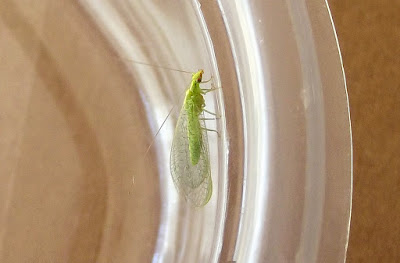Occupation:
|
Predator
|
Value
to Gardener:
|
5/5 - Pest Controller
|
Danger
to Humans:
|
2/5 – Harmless
|
Availability:
|
5/5 – They’ll arrive or you can buy some
|
 |
Lacewing Lifecycle: Chrysopa vulgaris by Lydekker, R. 1879 The Royal Natural History. Volume 6. Frederick Warne and Co. (from www.archive.org) |
Quick Intro
Lacewings adults are delicate wee fairy-folk of the vegetable garden… but do not let them fool you as they are voracious hunters of pest insects and their larvae are known as ‘aphid lions’ with the looks to match!
 |
| Lacewing first instar larvae and egg cases on stalks |
Science Stuff
Lacewings belong to the Neuroptera family of insects – they are not flies, in fact they are more closely related to beetles than flies (Ref 1). The order as a whole is very distinct in both their adult and larval appearance. Adults have elongated bodies reminiscent of dragonflies, but with transparent veined wings held in a dome above the body and iridescent eyes. Larvae have different body shapes and are similar in appearance to ladybug larvae but have very large mandibles. Several families are found within the order, but most of the pest controllers are located within the Chrysopidae family.
Habitat
As with many other pest predators; they will be attracted to areas with lots of prey species. Those most commonly found in gardens are the most widespread throughout South Africa. They are attracted to lights and thus you might find them inside the house – scoop them up and release back to the garden!
The 3 common species to look out for are:
1. Green lacewing: Chrysoperla species are green with a ~3 cm body and their wings have no markings. Found throughout South Africa.
 |
| Green lacewing, Chrysoperla species |
2. Yellow lacewing: Ceratochrysa antica are yellow and slightly larger than the green lacewing. Wings also have no markings. Likely to be found in Gauteng, KwaZulu-Natal, Mpumalanga, Limpopo and the eastern parts of the North West province.
 |
| Yellow Lacewing, Ceratochrysa antica |
3. Grey lacewing: Chrysemosa jeanneli are smaller than the green lacewings with grey bodies and grey wings. They have a distinctive black spot on the mid hind margin of their wings, which meet up when their wings are at rest. Found throughout South Africa.
 |
| Grey lacewing, Chrysemosa jeanneli |
The best way to attract predators is to limit synthetic pesticide use in the garden and to opt for environmentally friendly versions, which will not harm them (See my Pest Control Page). Unfortunately, pest populations have to become gargantuan in order to attract pest predators, but once they arrive they will sort out the infestation in double-quick time! For the adults who may feed on pollen/nectar – be sure to have plenty of small bloom plants as these are more suited to these insect’s size to get ahold of the contents. Lacewings have a preferential liking of Asteraceae flowers (sunflower, cosmos, dandelion) that make several tiny flowers in large clusters, as well as flowers from the Apiaceae family (dill, fennel and angelica).
Diet
In the family Chrysopidae, adults and larvae are mostly predatory and will feed on aphids and other soft-bodies homopterans (mites, scale, leafhoppers and mealy bugs). Adults from the grey lacewings are suspected to be pollen and nectar feeding (and hence might help out with pollination when feeding). Lacewing larvae are known as ‘aphid lions’ or ‘aphid wolves’ as they are able to devour up to 100 aphids a week! Grey lacewing larvae also display a type of camouflage behaviour by carrying devoured prey carcasses on their backs! [See Picture Here].
 |
| Green lacewing adult eating aphids |
 |
| Green lacewing larvae eating microscopic scale |
Lacewings: Mantidflies and Antlions
The order of Neuroptera have additional members outside of the agricultural pest control familes with some of the most interesting morphologies and lifecycles. These include the Mantidflies or mantispids (Mantispidae), which resemble miniature mantid-wasps! Adults use their raptorial forelimbs to grasp prey just like mantids. Mantidfly larvae feed on young spiders or spider eggs and pupate inside the egg sacs.
 |
| Mantidfly wasp mimic, Pseudoclimaciella species |
Antlions are the largest family of lacewings, best known for their whirl sand burrows wherein they catch unsuspecting ants. The larvae sit at the bottom of the funnel pit and when an ant happens to fall in it is unlikely to escape before the antlion snatches it up with its mandibles - although some jumping behaviour has been observed by would-be victims with various results. Antlion adults are large, lazy fliers. Some have spotted wings and/or resemble damselflies.
 |
| Spotted winged Antlion, Dendroleon obsoletus |
 |
| Ant traps - there be lions! |
For some websites where you can purchase lacewing eggs (Note these are likely not going to ship outside of the US!): Planet Natural & Arbico Organics
[Unfortunately such companies are not available in South Africa - we have to resort to the old fashioned way = by nature!]
[Unfortunately such companies are not available in South Africa - we have to resort to the old fashioned way = by nature!]
Ref 1: Neuroptera Phylogeny
______________________________________________________________________________
______________________________________________________________________________
Please share with fellow gardening enthusiasts via the various sharing buttons at the end of posts/pages! Else you can vote for posts through the Google reactions bar at the end of articles. To stay up to date I have provided several reader and social networking platforms with which to subscribe: Twitter, Pinterest, RSS Feed Reader or Email/Follow directly using the Blog Followers widget on the left hand side toolbar. Thank you for reading and please feel free to ask if questions arise - I appreciate comments and ideas too! 😆
_________________________________________________________________________________
